| Article ID | Journal | Published Year | Pages | File Type |
|---|---|---|---|---|
| 4498605 | Journal of Theoretical Biology | 2008 | 15 Pages |
This is the second in a series of three papers devoted to energy flow and entropy changes in chemical and biological processes, and to their relations to the thermodynamics of computation. In the first paper of the series, it was shown that a general-form dimensional argument from the second law of thermodynamics captures a number of scaling relations governing growth and development across many domains of life. It was also argued that models of physiology based on reversible transformations provide sensible approximations within which the second-law scaling is realized. This paper provides a formal basis for decomposing general cyclic, fixed-temperature chemical reactions, in terms of the chemical equivalent of Carnot's cycle for heat engines. It is shown that the second law relates the minimal chemical work required to perform a cycle to the Kullback–Leibler divergence produced in its chemical output ensemble from that of a Gibbs equilibrium. Reversible models of physiology are used to create reversible models of natural selection, which relate metabolic energy requirements to information gain under optimal conditions. When dissipation is added to models of selection, the second-law constraint is generalized to a relation between metabolic work and the combined energies of growth and maintenance.
